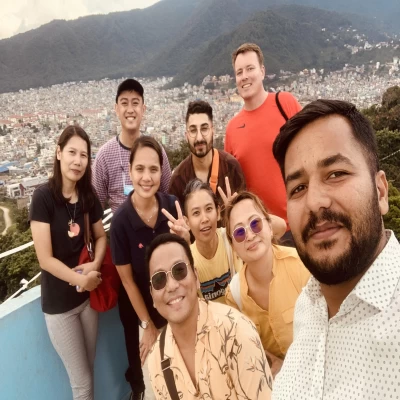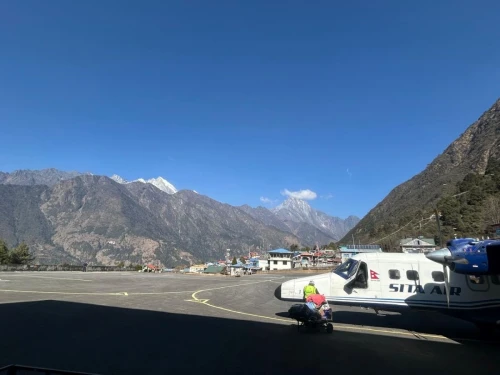About Weather Patterns of the Kanchenjunga Region
The Kanchenjunga region lies in eastern Nepal, near the border with India. Because this trek takes you from low valleys up to high mountain passes, the weather can change a lot depending on where you are and what time of year you visit.
In general, the region has four main seasons: spring, summer(monsoon), autumn, and winter. Each season brings its own kind of weather,scenery, and trekking experience.
Spring( March to May) is one of the best times to visit. The weather is warm but not too hot, the skies are substantially clear, and the trails come alive with blooming rhododendrons and other wildflowers. It’s a varied and lively time to journey.
Summer/ monsoon( June to September) brings heavy rain. The timber becomes lush and green, but the trails can be muddy and slippery. Leeches are also common, especially at lower altitudes. Visibility tends to be poor due to clouds and mist.
Autumn (mid-September to November) is another great time for trekking in Kanchenjunga. After the monsoon, the air is clean and clear, offering stunning views of the mountains. The days are generally dry and sunny, making it the most popular season for this journey.
Winter( December to February) is cold, especially in the advanced regions. Snow may block some high passes, and temperatures can drop well below freezing. Still, if you are well-prepared and enjoy quieter trails, downtime can be peaceful and beautiful.
Overall, the rainfall in the Kanchenjunga region can be changeable, especially at the advanced mountain. It’s always a good idea to check the forecast before your journey and be prepared for unforeseen changes in temperature and conditions.
Best Seasons for the Kanchenjunga Circuit Trek
Choosing the right time to do the Kanchenjunga Circuit Trek is important, especially because this journey is long, remote, and relatively grueling. Some months offer clear skies and stunning mountain views, while others come with rain, snow, or muddy trails. Let’s break down the best times to go
Spring ( March to May)
Spring is one of the best times to journey in the Kanchenjunga region. The weather is affable, not too hot, not too cold. The skies are generally clear, which means you’ll get amazing views of the snow-covered mountains.
One of the best parts? The forests along the trail are full of blooming rhododendrons and other flowers. It’s a beautiful time to walk through nature, and the trails are in good condition.
Good for Great mountain views, flower lovers, and first-time visitors to the region.
Autumn (Mid-September to November)
Autumn is another perfect season for the Kanchenjunga Circuit Trek. After the monsoon rains are over, the air becomes clean and fresh. The weather is dry, the skies are crystal clear, and you’ll see the mountains in full glory.
This is also the most popular time for trekking in Nepal, so you might meet many further trekkers along the way but the Kanchenjunga region is no way too crowded, so it’s still peaceful.
Good for Clear skies, incredible views, and the best trekking conditions around.
Off-Season for Kanchenjunga Circuit Trek
While spring and autumn are the most recommended times for trekking in the Kanchenjunga region, some people still wonder, “ What if I go in winter or during the monsoon? ” Let’s break down what to expect in those less popular seasons so you can decide for yourself.
Winter ( December to February)
Winter in the mountains sounds magical, and it is, but it also comes with challenges. The temperature drops a lot, especially at higher altitudes. You’ll likely face snow on the trails, and some high mountain passes may be closed due to heavy snowfall.
- What to expect: cold mornings and nights, snow-covered trails, and very few other trekkers.
- Pros: Peaceful trails and beautiful snowy views.
- Cons: Extremely cold, limited tea house services, threat of route closures.
- Good for Experienced: trekkers who enjoy solitude and are prepared for cold weather.
Monsoon / Summer ( June to Mid-September)
Monsoon is the rainy season in Nepal. During this time, clouds often cover the mountains, and it rains a lot especially in the Kanchenjunga region, which is close to India and gets more rainfall than western Nepal.
- What to expect: Muddy and slippery trails, leeches in the forest areas, cloudy skies.
- Pros: Lush green landscapes and fewer crowds.
- Cons: Poor mountain views, high risk of landslides, uncomfortable trail conditions.
- Good for Adventurous: trekkers who don’t mind getting wet and want to see the landscape in full bloom.
- If you're a beginner or first-time trekker, it's best to avoid these two seasons unless you’re going with an experienced guide and are fully prepared for tough conditions. Spring and autumn offer a much safer and more enjoyable experience for most people.
What's the Weather Like in Each Season?
It’s very helpful to understand what the weather will be like during different times of the year, if you are planning the Kanchenjunga Circuit Trek. From sunny skies to snowy paths or rainy trails ,each season brings its own feel, temperature, and scenery.
To make effects simple, here's a table showing what you can expect in each season, including temperature, trail conditions, and which kind of traveller might enjoy it most.
| Season | Temperature
(Day) | Weather | Trail
Conditions | Views | Good
For |
| Spring | 6°C to 18°C | Warm and dry,
clear skies | Flowers
blooming, dry
trails | Amazing
mountain views | Nature lovers,
flower hunters |
| Autumn | 5°C to 15°C | Cool and clear,
no rain | Firm trails,
colourful
forests | The best views | All trekkers, great
photography |
| Winter | -10°C to 5°C | Very cold,
some snowfall | Snowy and icy
paths, fewer
people | Still clear | Experienced
Trekkers who like
peace |
| Monsoon | 12°C to 20°C | Rainy and
cloudy | Muddy trails,
slippery, lots of
greenery | Often cloudy | Offbeat travellers,
greenery lovers |
Tip: It gets much colder at night and in higher areas, so pack warm clothes even if it’s spring or autumn.
In Conclusion
If you're planning the Kanchenjunga Circuit Trek, choosing the right time makes a difference. The best times to go are spring (March to May) and autumn (mid-September to November).
These months offer the clearest skies, beautiful mountain views, and good trail conditions perfect for both beginners and experienced trekkers.



 2 reviews
2 reviews


